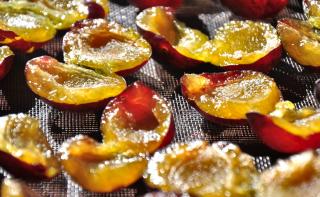

The plum or Prunus domestica belongs to the Rosaceae family. This delicate fruit with smooth skin is to be savored during the summer season.
The tree, called the plum tree, can reach 16 to 20 feet (5 to 6 m) tall, and appreciates spots with a lot of sun.
Many are aware of the famous Reine-Claude greengage but there are many other plum varieties that come in various colors, like the Mirabelles (yellow), the Damsons (blue), the ‘d’Ente’ and many more.
This delicious sweet fruit is nutritional gold mine. Not only is the flesh the color of gold, but its properties are valuable to our skin and bodies.
Even today, the plum tree‘s past isn’t properly traced back. Some find that it is related to Asian plants.
What is for certain is the date it was introduced to Europe: the Middle Ages. And the Renaissance is when it became famous.
Claude de France, one of the wives of François the Ist, was enthralled with the fruit, and one variety, the “Reine-Claude”, was named after her.
The plum has traveled the world. Indeed, plum stones have been unearthed in archaeological dig sites. Moreover, the Egyptians stored dried plums under the Pyramids, in the tombs.
The prune was also widely grown in Syria, where the Crusaders were stopped.
Very rich in fiber, plum is a powerful laxative. Ideal in case of constipation and of intestinal disorders to accelerate transit.
Its dried fruit, the prune, is also very much recommended to cleanse the digestive tract.
Recommendation: to regulate your intestinal transit, eat two to four prunes every morning.
Plum is also a very good diuretic. Gorged with 83% water, it has hydrating activity and reduces urinary disorders, allowing for urination to resume.
They regulate arterial blood pressure, thanks to the presence of potassium. And they also reduce bad cholesterol levels which is of great service for our arteries.
Thus, plums contribute to limiting appearance of cardiovascular diseases.
Eat plums or prunes to stock up on antioxidants
Indeed, they are filled with antioxidants, thus protecting our body’s cells from damage caused by free radicals: development of cancerous cells, premature skin and cell ageing.
Athletes simply love it. Plum is a true source of energy. However, for diabetic persons, don’t indulge. Plums are very sweet fruits and prunes are even sweeter.
It is recommended to feast on plums in case of anemia and of deep exhaustion.
Plum will provide you with interesting amounts of vitamins A, B, C and E to stimulate your memory and your body’s immune defense system. As well as many crucial minerals: potassium, magnesium, calcium and phosphorus.
Eating plums and prunes is prescribed in case of constipation, exhaustion, physical activity, to reinforce bone density and avoid osteoporosis.
Calorie intake of plum: 46 à 60 kcal / 3.5 oz (100 g) depending on the variety.
Its fats content is reasonable:0.28 g / 3.5 oz (100 g) whereas sugars are more important: 9,6 g /3.5 oz (100 g).
Plum is also potassium-rich, and has vitamin C, B9 and beta-carotene.
Ah, the plum! This delicious sweet fruit can be savored both raw and cooked.
With plums, excellent jams and compotes can be prepared.
And a number of very savory pies.
To avoid any trace of tangy acidity: layer the pie crust with as much flour as you do sugar.
We also like adding plums to fruit salad, clafoutis, and crumbles.
Prunes are excellent with meat roasts or in the famed lamb tajine.
Heat plums in a frying pan on low. Add vanilla-flavored sugar and sliced almonds. Eat as you wish, either warm or cold with cottage cheese.
Prune roast – Slice your roast meat. Between each slice of meat, wedge a piece of cheeseburger cheddar. Surround your roast with prunes before sliding into the oven to bake.
For appetizers, skewer sweet-and-salty items on sticks – alternate smoked Bayonne ham with a cube of cantaloupe and half a prune.
We also like plums for its benefits in cosmetology.
The astringent properties of plums help close skin pores when they’re open and gives a glow to your skin.
This fragile fruit doesn’t keep very well. Eat it immediately.
To increase its keeping for a few days, store in the cold, in the vegetable compartment of your refrigerator.

To clear all imperfections from your skin: apply plum juice on your face with a cotton ball and rinse off.
Credits for images shared to Nature & Garden (all edits by Gaspard Lorthiois):
Plums in basket by mac231 under Pixabay license
Plums drying by danastajic016 under Pixabay license